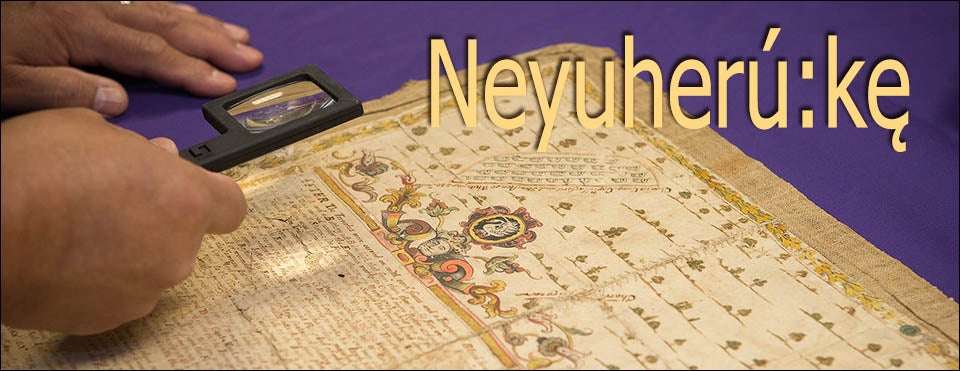NOOHEROOKA 300
ECU, Tuscarora Nation to mark anniversary
This month, East Carolina University will solemnly mark a Colonial era battle that redefined North Carolina and changed the direction of American history with a three-day event, “Nooherooka 300.”
Approximately 30 miles from ECU’s campus lies the site of Fort Neyuherú:kę (English spelling, Nooherooka), which was the location of a bloody battle between colonists—aided by various Indian allies—and the members of the Tuscarora Nation in 1713.

Neil Patterson Sr., left studies a map of the Tuscarora Fort Nooherooka at ECU’s Joyner Library. At right is ECU history professor Larry Tise.
When the fighting ended, hundreds of Tuscarora Indians were dead, scalped or enslaved. The 300th anniversary of that battle will be commemorated March 21-23 through a series of events at the historic site in Greene County and on ECU’s campus.
Not only will historians give accounts of the battle and its consequences, but members of the Tuscarora Nation will also discuss their historic homeland, their language and their culture.
After dedicating a monument at the battle’s site on Saturday, March 23, members of the Tuscarora delegation will begin their own migration—on foot—back to New York where their ancestors found a new home as the Sixth Nation of the Iroquois Confederacy. Today, members of the Tuscarora Nation live about 15 miles from Niagara Falls, N.Y.
A core group of members plan to hike, bike and canoe the more than 600 miles back to New York with fellow Tuscarora joining them for segments along the way. They are allotting 70 days for the journey.
The three-day symposium will focus on the 1,000-year period prior to 1713 when the Tuscarora people lived on the land that is now eastern North Carolina, the consequences of a battle that drove the Tuscarora Nation out of North Carolina, and the history, traditions and memory of the Tuscarora homeland.
“This is probably the most solemn commemoration of the deep and complex history of eastern North Carolina we could undertake–right alongside meditating upon the meanings of the American Revolution and the American Civil War,” said Dr. Larry Tise, Wilbur & Orville Wright Distinguished Professor of History at ECU.
“They were two great wars that gave shape and meaning to the America we know, but neither of those did as much to shape the character and heritage of eastern North Carolina as did the Tuscarora War of 1711-1713.”
One of the featured events of the weekend will be the display and discussion of the 18th century parchment map detailing the famous battle at Fort Nooherooka. Tise has been working with his colleague Susanne Grieve, director of conservation at ECU, to lead a team studying the battle map, attributed to South Carolina commander of the assault Colonel James Moore.
The map is owned by the South Carolina Historical Society, which has committed funds – along with ECU – to support the map’s conservation.

Chief Stuart Patterson stands in the field where a monument will be installed to commemorate the Nooherooka fort and the war that took place there. ECU sculpture professor Hanna Jubran is developing the memorial.
The map of the battle was of particular interest to Chief Patterson and Neil Patterson Sr. during a trip to campus in the fall when they saw the colorfully illustrated map for the first time.
Chief Patterson noted that he had seen a sketch of the map before, but not the actual map.
Patterson Sr. said it was an odd feeling to see a drawing that reflected the attack on his ancestors’ fort, which he noted on the map looked like Iroquois villages and forts in the North.
“It is looking at death. (The map) is about how to kill the Tuscarora and we know how it was used,” he said. “It needs to be preserved. We lost 20 percent of our people.”
Francene Patterson, who works to preserve the Tuscarora language, is one of the almost 150 members of the Tuscarora Nation who plan to attend the events.
“It is a once in a lifetime event for us. Kids are being taken out of school,” she said. “Everybody is excited to see the actual site of the fort, attend the commemoration activities and see the actual map.”
Patterson said she expects it will be an emotional weekend for many of her fellow Tuscarora. “We’ll be going where our ancestors were walking at one time. It’s almost indescribable. The awe and the excitement we’re feeling. It’s something we’re looking forward to.
“We’re thinking about what they had to go through – the wars and then the journey to come up here,” she said from her home on the Tuscarora Reservation.
